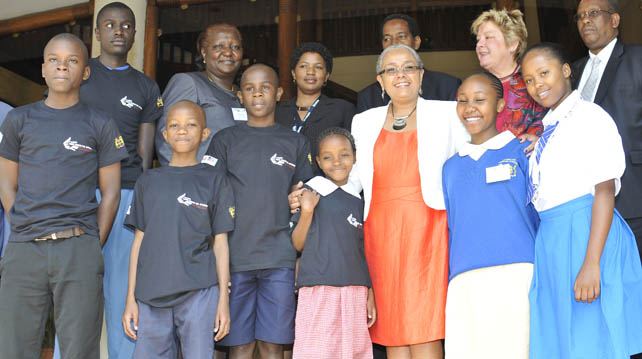Young People Are Making Noise - and We Should Listen
This blog can also be read on Interaction's website.
As the global community buzzes about the post-2015 framework, the next set of Millennium Development Goals, and ending poverty once and for all, we must listen and consider some of the most important voices: those of the world’s poorest citizens, especially those of impoverished young people.
Last month, Kenya’s First Lady Margaret Gakuo was invited to take a stroll down a red carpet at an event supporting local orphans and vulnerable children.
But the first lady was far from the star of the show.
Instead, the spotlight belonged to 150 young people who showed off their drawings, photography, sculptures, and paintings as a part of the event hosted by Pathfinder International, ChildFund Kenya, and USAID.
The youth participate in an initiative called “Nipe Nafasi,” a part of the USAID-funded APHIAplus project that gives them an opportunity to voice their needs about various issues affecting their lives through art, drama, and a magazine called “Kengele”—Swahili for “make some noise.”
At the event, the first lady agreed to champion the rights and needs of Kenya’s impoverished, orphaned, and disabled children. And she underscored a crucial point that lies at the heart of the Nipe Nafasi initiative. Youth are the future. Their voices must be included—and incorporated—into our development programs if we are to end poverty.
The United Nations estimates that nearly 2.6 million Kenyan children are orphans, and more than half of them have been orphaned by AIDS.
Losing one or both parents often means responsibility falls on the oldest child’s shoulders. These children are expected to provide for their families, sometimes becoming the sole caretaker for their young siblings.
Nonprofits, international agencies, and governments from around the globe are working hard to bring education, nutrition, food, health, and even bicycles to orphans like those involved in Nipe Nafasi.
Some, including the government of Kenya, have recognized the need to financially support orphans and vulnerable children who have become caretakers by setting up cash transfer schemes, which have seen varied success.
These efforts will be key to help Kenya’s newest generation stay in school, stay healthy, and achieve financial stability and independence. Good intentions aside, it’s time that we stop and reflect. When was the last time we asked these “young” people – living very adult lives – what they need to survive or what they want out of their lives?
Young people around the world want to be heard and it’s time we listen.
The artwork exhibited at the recent Nipe Nafasi event is a prime example of giving youth the voice they so need and desire. The list of needs expressed through their artwork may seem simple at first glance—education, health, food, and safety—but each piece of art shares a new story that provides insight into the unique set of challenges that impoverished young people face. The challenges we must face if we hope to end global poverty.
Ten-year-old Dorington Omondi shared his painting of children working in quarries, bringing the issue of child labor to life.
Thirteen-year-old Joseph Ochieng took a photograph of a child playing on railroad tracks, signifying the dangers children living in slums are exposed to every day.
Efforts like Nipe Nafasi give young people like Dorington and Joseph a voice through art, but also through vocational training and “dream career” activities, supporting research about the education they may want to pursue to land the career they have their eye on.
As the global community buzzes about the post-2015 framework, the next set of Millennium Development Goals, and ending poverty once and for all, we must listen and consider some of the most important voices—those of the world’s poorest citizens, especially those of impoverished young people.
Their future, and our collective global future, depends on giving these young people a voice and a chance to steer the conversation.
We can end extreme poverty. It starts with listening.
This post is part of a series produced by the NGO alliance InterAction around the International Day for the Eradication of Poverty. You can read about projects that are making a difference on InterAction’s NGO Aid Map. Read all the posts in the series, follow the conversation on Twitter with #EndPoverty, and raise your voice to end extreme poverty.



 Follow Pathfinder
Follow Pathfinder